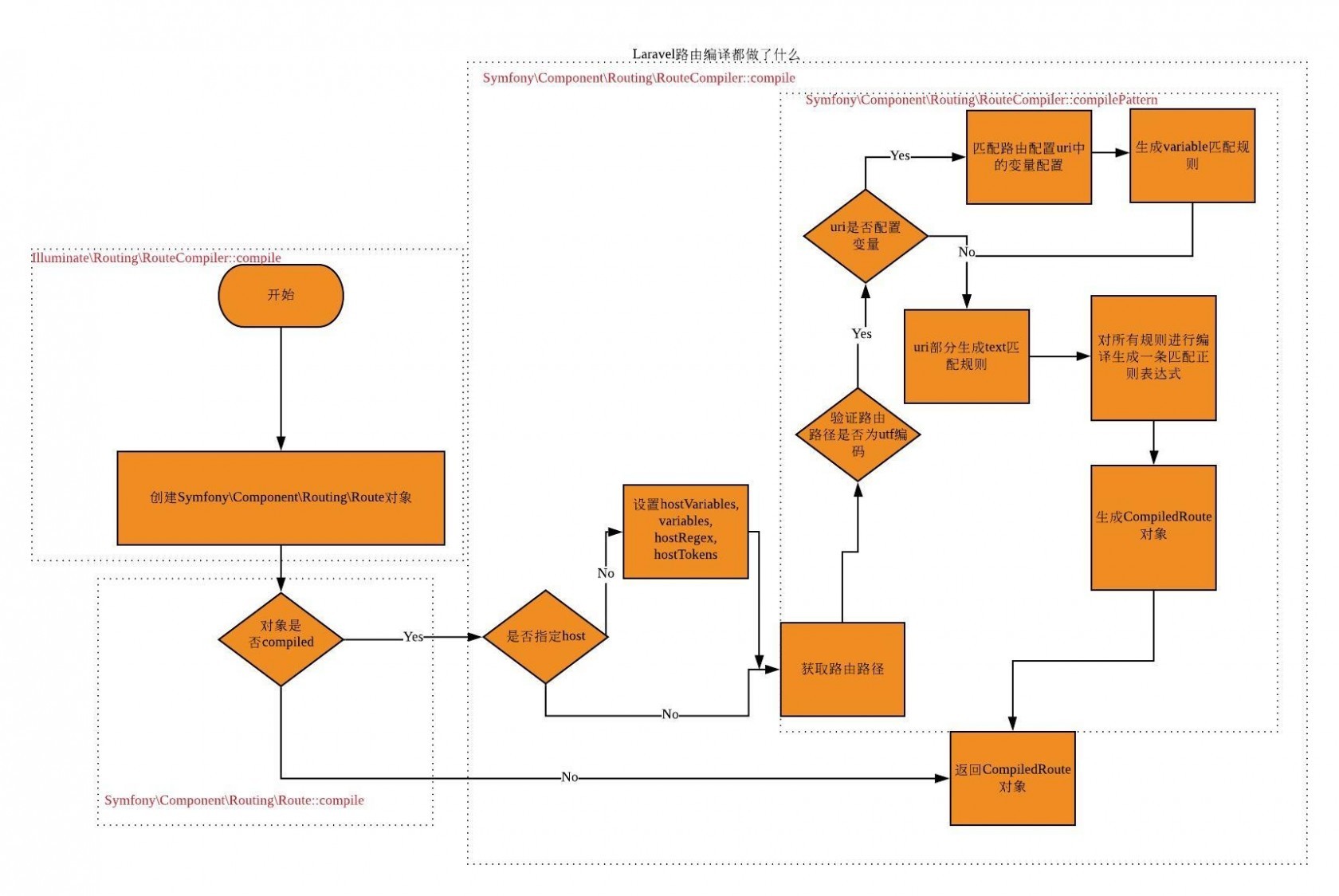老王带你看源码|Laravel 的路由匹配的过程都干了些什么?
Laravel 的路由配置有很多,可以设置域名,设置请求协议,设置请求方式,请求路径。那么,Laravel在获取到请求之后,去匹配路由都做了些什么呢?本文以Laravel5.8源码讲解,带你一步步看源码。
文章首发于公众号【写PHP的老王】,更多内容可以关注公众号
Laravel 路由解析实例
Laravel 默认路由的验证器有四个,UriValidator,MethodValidator,SchemeValidator,HostValidator分别处理uri的匹配,请求方法的匹配,协议的匹配,域名的匹配。
举几个例子:
HostValidator验证域名是符合domain的配置
Route::domain('{account}.blog.dev')->function({
return 'Hello';
});-
UriValidator验证请求的uri是否符合路由配置,MethodValidator验证当前请求方法是否是get方法Route::get('/home/posts/{id?}',function($id=null){ return 'get post '.$id; }) -
SchemeValidator验证访问协议,主要用于验证安全路由。只能验证是http,或者https
Route::get('foo', array('https', function(){}));只有当四个验证器都通过才认为当前请求匹配路由成功。
那这四个验证器都是怎么验证的呢?
Laravel 路由匹配验证器
请求方法验证
class MethodValidator implements ValidatorInterface
{
public function matches(Route $route, Request $request)
{
return in_array($request->getMethod(), $route->methods());
}
SchemeValidator
}请求方式的验证最简单,就是验证当前请求方式是否是当前路由允许的请求方式。而路由的允许的请求方式在路由实例化的时候就创建好了。
请求协议验证
class SchemeValidator implements ValidatorInterface
{
public function matches(Route $route, Request $request)
{
if ($route->httpOnly()) {
return ! $request->secure();
} elseif ($route->secure()) {
return $request->secure();
}
return true;
}
}通过获取当前请求的Request,判断是否是https,与当前路由的配置进行比较
域名验证以及uri的验证
这两种验证本质上都是一样的。通过对路由的配置进行编译分解,获取uri获取域名匹配的正则表达式,然后通过正则表达式进行匹配。如果匹配成功,则验证通过。
这里以UriValidator为例说明
class UriValidator implements ValidatorInterface
{
/**
* Validate a given rule against a route and request.
*
* @param \Illuminate\Routing\Route $route
* @param \Illuminate\Http\Request $request
* @return bool
*/
public function matches(Route $route, Request $request)
{
$path = $request->path() === '/' ? '/' : '/'.$request->path();
return preg_match($route->getCompiled()->getRegex(), rawurldecode($path));
}
}这里的关键是getCompiled返回的这个对象。getCompiled返回的是Symfony\Component\Routing\CompiledRoute这个对象包含了当前路由编译之后的uri匹配正则表达式,域名匹配正则表达式等信息。
CompiledRoute是谁返回的?
在每个路由获取验证器进行验证之前,都会执行compileRoute方法创建CompiledRoute对象。
//Illuminate\Routing\Route
public function matches(Request $request, $includingMethod = true)
{
$this->compileRoute();
foreach ($this->getValidators() as $validator) {
if (! $includingMethod && $validator instanceof MethodValidator) {
continue;
}
if (! $validator->matches($this, $request)) {
return false;
}
}
return true;
}
protected function compileRoute()
{
if (! $this->compiled) {
$this->compiled = (new RouteCompiler($this))->compile();
}
return $this->compiled;
}Illuminate\Routing\RouteCompiler中compile方法如下:
//use Symfony\Component\Routing\Route as SymfonyRoute;
public function compile()
{
$optionals = $this->getOptionalParameters();
$uri = preg_replace('/\{(\w+?)\?\}/', '{$1}', $this->route->uri());
return (
new SymfonyRoute($uri, $optionals, $this->route->wheres, ['utf8' => true], $this->route->getDomain() ?: '')
)->compile();
}//Symfony\Component\Routing\Route 代码
//compiler_class Symfony\\Component\\Routing\\RouteCompiler
public function compile()
{
if (null !== $this->compiled) {
return $this->compiled;
}
$class = $this->getOption('compiler_class');
return $this->compiled = $class::compile($this);
}
可以看出,最终是由Symfony\Component\Routing\RouteCompiler的compile返回最终的compileRoute对象。
路由编译都干了些什么?
//Symfony\Component\Routing\RouteCompiler 源码
public static function compile(Route $route)
{
...
if ('' !== $host = $route->getHost()) {
$result = self::compilePattern($route, $host, true);
$hostVariables = $result['variables'];
$variables = $hostVariables;
$hostTokens = $result['tokens'];
$hostRegex = $result['regex'];
}
...
}RouteCompiler::compile输入参数是当前需要匹配的路由。首先判断路由是否有域名配置,如果有域名配置则对域名配置进行正则表达式编译,获取域名的匹配正则表达式,已经匹配表达式中的变量信息。
//Symfony\Component\Routing\RouteCompiler 源码
public static function compile(Route $route)
{
...
$path = $route->getPath();
$result = self::compilePattern($route, $path, false);
$staticPrefix = $result['staticPrefix'];
$pathVariables = $result['variables'];
...
$variables = array_merge($variables, $pathVariables);
$tokens = $result['tokens'];
$regex = $result['regex'];
...
}
然后获取路由的uri配置,对配置进行解析获取配置中的匹配正则表达式,变量数组,前缀信息。
域名,路径匹配规则解析之后,根据解析后的数据创建一个CompiledRoute对象,并返回
因此,在路由编译过程中,主要是根据路由配置,解析出匹配的正则表达式,变量数组,前缀信息。并将这些解析之后的数据创建的CompiledRoute对象返回给调用方。这样,调用方就能够直接通过CompiledRoute的属性直接获取到路由解析之后的匹配规则。
匹配规则怎么解析的?
//Symfony\Component\Routing\RouteCompiler 源码
private static function compilePattern(Route $route, $pattern, $isHost)
{
...
preg_match_all('#\{(!)?(\w+)\}#', $pattern, $matches, PREG_OFFSET_CAPTURE | PREG_SET_ORDER);
foreach ($matches as $match) {
...
if ($isSeparator && $precedingText !== $precedingChar) {
$tokens[] = ['text', substr($precedingText, 0, -\strlen($precedingChar))];
} elseif (!$isSeparator && \strlen($precedingText) > 0) {
$tokens[] = ['text', $precedingText];
}
...
if ($important) {
$token = ['variable', $isSeparator ? $precedingChar : '', $regexp, $varName, false, true];
} else {
$token = ['variable', $isSeparator ? $precedingChar : '', $regexp, $varName];
}
...
}
...
}
首先通过正则表达式匹配是否由变量配置,例如Route::get('/posts/{id}'),Route::domain('{account}.blog.dev')。如果有变量,则对配置规则进行截取,将配置规则中不包含变量的部分$tokens[] = ['text', $precedingText]; ,对所有变量$token = ['variable', $isSeparator ? $precedingChar : '', $regexp, $varName, false, true]保存解析后的信息。
//Symfony\Component\Routing\RouteCompiler 源码
private static function compilePattern(Route $route, $pattern, $isHost)
{
...
if ($pos < \strlen($pattern)) {
$tokens[] = ['text', substr($pattern, $pos)];
}
// find the first optional token
$firstOptional = PHP_INT_MAX;
if (!$isHost) {
for ($i = \count($tokens) - 1; $i >= 0; --$i) {
$token = $tokens[$i];
// variable is optional when it is not important and has a default value
if ('variable' === $token[0] && !($token[5] ?? false) && $route->hasDefault($token[3])) {
$firstOptional = $i;
} else {
break;
}
}
}
...当配置信息中不包含任何变量,则进入这段代码中第一个if判断里面,将匹配规则保存在token数组中。
区分当前解析是对域名的匹配还是对uri的匹配,如果对uri的匹配,则找出变量中第一个可选参数的位置。
这一步是把路由配置转换成可匹配的规则token。方便后续通过每个token生成匹配正则表达式。
//Symfony\Component\Routing\RouteCompiler 源码
private static function computeRegexp(array $tokens, int $index, int $firstOptional): string
{
$token = $tokens[$index];
if ('text' === $token[0]) {
return preg_quote($token[1], self::REGEX_DELIMITER);
} else {
if (0 === $index && 0 === $firstOptional) {
return sprintf('%s(?P<%s>%s)?', preg_quote($token[1], self::REGEX_DELIMITER), $token[3], $token[2]);
} else {
$regexp = sprintf('%s(?P<%s>%s)', preg_quote($token[1], self::REGEX_DELIMITER), $token[3], $token[2]);
if ($index >= $firstOptional) {
$regexp = "(?:$regexp";
$nbTokens = \count($tokens);
if ($nbTokens - 1 == $index) {
// Close the optional subpatterns
$regexp .= str_repeat(')?', $nbTokens - $firstOptional - (0 === $firstOptional ? 1 : 0));
}
}
return $regexp;
}
}
}通过解析获取的token数组,保存了所有的匹配规则数组。如果当前匹配规则token是text类型,则在对字符串进行转义处理,返回作为匹配的正则表达式。
如果是变量,则根据是否是可选的(上一步已经找到了第一个可选参数的位置),在正则表达式中添加可选标识。
//Symfony\Component\Routing\RouteCompiler 源码
private static function compilePattern(Route $route, $pattern, $isHost)
{
...
$regexp = '';
for ($i = 0, $nbToken = \count($tokens); $i < $nbToken; ++$i) {
$regexp .= self::computeRegexp($tokens, $i, $firstOptional);
}
$regexp = self::REGEX_DELIMITER.'^'.$regexp.'$'.self::REGEX_DELIMITER.'sD'.($isHost ? 'i' : '');
...
return [
'staticPrefix' => self::determineStaticPrefix($route, $tokens),
'regex' => $regexp,
'tokens' => array_reverse($tokens),
'variables' => $variables,
];根据每个token获取每个匹配规则的正则表达式,将所有的正则表达式拼接成一个正则表达式,并加上正则表达式前后缀。这样就获取了一个完整可匹配的正则表达式。
然后将前缀,匹配正则表达式,匹配规则数组tokens,变量数组返回给调用方。供调用方生成CompiledRoute对象。
总结
文章比较长,主要是根据调用链一步步分析每个方法的作用,介绍Laravel如何实现路由匹配的动能,希望对大家有帮助。最后附上Laravel路由匹配过程调用流程图

本作品采用《CC 协议》,转载必须注明作者和本文链接






 关于 LearnKu
关于 LearnKu




推荐文章: